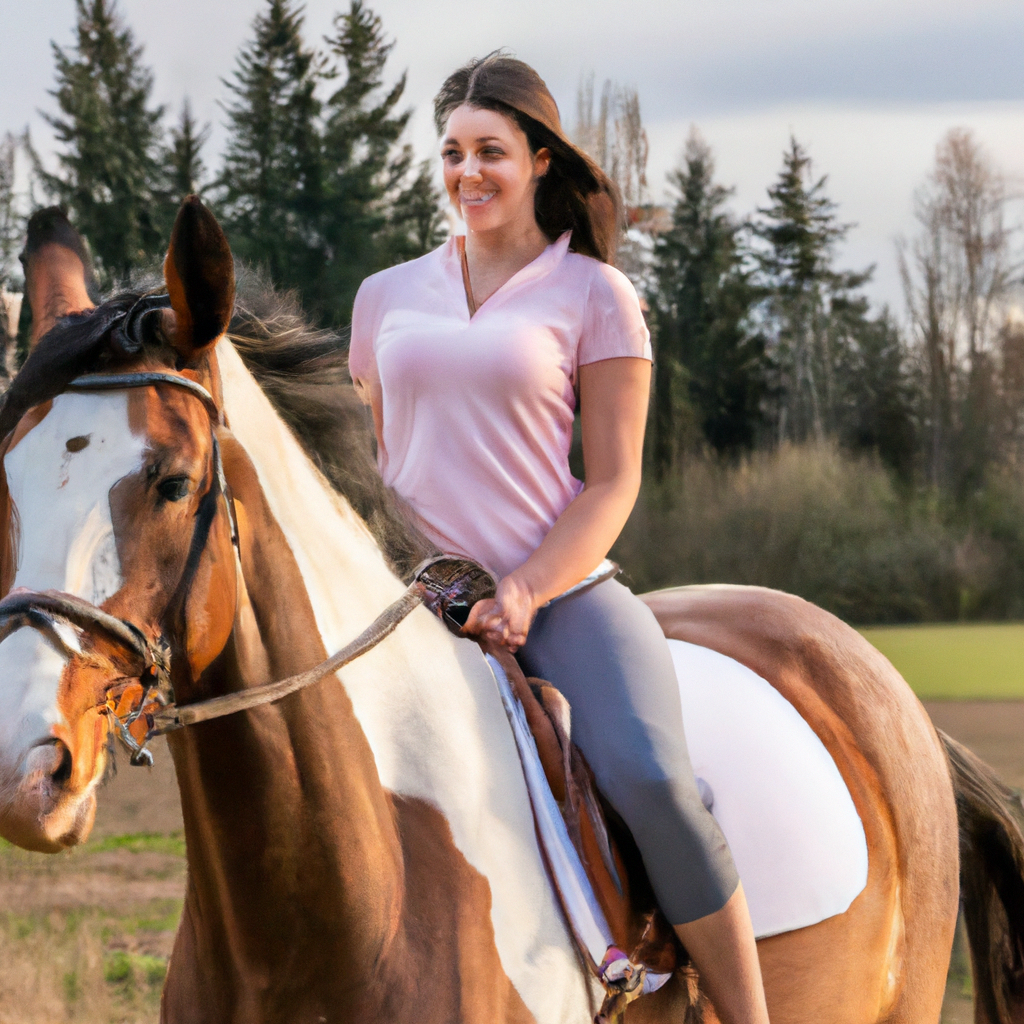Horseback riding has long been known as an enjoyable and exhilarating activity, but did you know that it also plays a significant role in equine therapy? In this article, we will explore the connection between horseback riding and its therapeutic benefits for individuals with physical, emotional, and cognitive challenges. From improving balance and coordination to boosting self-esteem and confidence, horseback riding has proven to be an effective form of therapy for a wide range of conditions. So, saddle up and join us as we delve into the world of equine therapy and discover how horseback riding can positively impact the lives of both riders and horses.
Benefits of Equine Therapy
Equine therapy is a unique and effective form of therapy that involves interactions between individuals and horses. It has gained popularity in recent years due to its numerous physical, emotional, and mental benefits. In this article, we will explore these benefits in detail, as well as the different types of equine therapy, the importance of choosing the right horse, the equipment required, safety measures, training for professionals, research and studies, and some inspiring success stories.

Physical Benefits
One of the significant advantages of equine therapy is its physical benefits. Horseback riding involves the use of various muscles that help improve strength, balance, and flexibility. The motion of the horse while walking or trotting stimulates the muscles in the rider’s back, core, and legs, contributing to improved posture and overall muscle tone. This physical activity can be particularly beneficial for individuals with physical disabilities or conditions such as cerebral palsy or multiple sclerosis.
Emotional Benefits
Equine therapy also offers profound emotional benefits. Interacting with horses has a calming and soothing effect on individuals, reducing stress and promoting relaxation. Horses are incredibly perceptive animals, and their gentle nature and non-judgmental demeanor create a safe and nurturing environment for emotional healing. Building a connection with a horse can help individuals develop trust, empathy, and emotional regulation skills, resulting in improved self-esteem and confidence.
Mental Benefits
In addition to the physical and emotional benefits, equine therapy can have a positive impact on mental health. Spending time with horses and participating in various activities stimulates cognitive abilities such as problem-solving, decision-making, and focus. The responsibility of caring for a horse, including grooming and feeding, can also promote a sense of purpose and accomplishment. Equine therapy has shown promising results in improving symptoms of mental health conditions such as anxiety, depression, and post-traumatic stress disorder (PTSD).
How Horseback Riding Helps in Equine Therapy
Horseback riding plays a crucial role in equine therapy by providing unique sensory stimulation and promoting various physical and mental skills. Let’s delve into some specific ways in which horseback riding can help individuals in therapy.
Sensory Stimulation
The rhythmic motion of a horse’s gait provides sensory stimulation that can be highly beneficial for individuals with sensory processing disorders, such as autism spectrum disorder (ASD). It helps individuals develop sensory integration skills, improves body awareness, and enhances sensory regulation.
Motor Control
Horseback riding requires coordination of multiple muscle groups, promoting the development and improvement of motor skills. Individuals learn to control their body movements, maintain balance, and adjust posture according to the horse’s motion. This can be particularly beneficial for individuals with motor control issues or coordination difficulties.
Balance and Coordination
Maintaining balance and coordinating movements while riding a horse helps individuals improve their overall balance and coordination. This can be especially valuable for individuals with conditions such as cerebral palsy or those recovering from injuries or surgeries that affect their motor skills.
Building Relationships
Interacting with a horse creates opportunities for individuals to develop and nurture relationships. Horses are highly perceptive animals and can sense emotions and react accordingly. Through regular interactions, individuals learn to communicate effectively, build trust, and establish a bond with their therapy horse. These relationship-building skills can then translate into improved social interactions with humans.
Boosting Self-confidence
Accomplishing tasks while working with horses, such as successfully riding or completing grooming activities, boosts self-confidence in individuals. It provides a sense of achievement, empowers individuals to overcome challenges, and fosters a positive self-image.

Types of Equine Therapy
Equine therapy encompasses various approaches and techniques that cater to different therapeutic needs. The three primary types of equine therapy are therapeutic horseback riding, hippotherapy, and equine-assisted psychotherapy.
Therapeutic Horseback Riding
Therapeutic horseback riding involves structured riding sessions with specific goals in mind. Trained instructors guide individuals through various exercises, focusing on improving physical, emotional, and cognitive skills. This type of therapy is suitable for a wide range of individuals, including those with physical disabilities, sensory processing disorders, and mental health conditions.
Hippotherapy
Hippotherapy is a form of therapy that utilizes the movement of a horse to provide benefits such as improved posture, balance, and coordination. In hippotherapy sessions, therapists work closely with individuals, using the horse’s movement to address specific therapeutic goals. This type of therapy is particularly effective for individuals with physical disabilities or motor control difficulties.
Equine-Assisted Psychotherapy
Equine-assisted psychotherapy combines horses with traditional psychotherapy techniques. Qualified mental health professionals use interactions between individuals and horses as metaphors and analogies to explore emotions, behaviors, and beliefs. This approach helps individuals gain insight, develop coping strategies, and enhance their overall well-being.
Choosing the Right Horse for Equine Therapy
When it comes to equine therapy, choosing the right horse is crucial to ensure a safe and effective therapeutic experience. Here are a couple of key considerations when selecting a therapy horse:
Temperament
A therapy horse should possess a calm and patient temperament, as they will be working with individuals who may have physical or emotional challenges. Horses that are easily spooked or easily agitated may not be suitable for equine therapy. It is essential to assess a horse’s temperament and ensure they have a gentle and forgiving nature.
Size and Strength
The size and strength of a horse are also important factors to consider. The horse should be appropriately sized to accommodate the individuals participating in therapy. Additionally, the horse should be strong and healthy enough to handle the physical demands of therapeutic horseback riding or other equine therapy activities.
Equipment for Equine Therapy
Equine therapy requires specific equipment to ensure the safety and comfort of both the individuals and the therapy horses. Here are some essential pieces of equipment used in equine therapy:
Saddles and Bridles
Comfortable and well-fitted saddles and bridles are vital for the rider’s stability and control. Therapeutic saddles are designed to provide support and distribute the rider’s weight evenly. Bridles should fit properly to ensure clear communication between the rider and the horse.
Pads and Blankets
Pads and blankets are used to cushion the horse’s back and provide additional comfort. They help distribute pressure and prevent friction between the horse and the saddle. Proper padding is essential to prevent discomfort or injury to both the horse and the rider.
Safety Measures in Equine Therapy
Safety is paramount in equine therapy to prevent accidents and ensure the well-being of all participants. Here are some crucial safety measures to be followed:
Proper Mounting and Dismounting
Proper technique for mounting and dismounting is essential to avoid injuries. Individuals should be guided and assisted by trained professionals during these processes to ensure proper positioning and reduce the risk of falls.
Wearing Helmets and Protective Gear
The use of safety helmets is highly recommended during all equine therapy sessions, especially when riding. Helmets protect individuals from head injuries in case of falls or accidents. Additionally, depending on the specific activities involved in therapy, individuals may be required to wear additional protective gear such as body protectors or riding boots.
Training for Equine Therapy Professionals
Equine therapy professionals, including instructors and therapists, require specific training to effectively work with individuals in therapy. Here are some key aspects of training for equine therapy professionals:
Certifications
Professionals in equine therapy should obtain relevant certifications from reputable organizations. These certifications ensure that individuals have received proper training and have demonstrated competence in working with horses and facilitating equine therapy sessions.
Continuing Education
Continuing education is crucial for equine therapy professionals to stay updated with the latest research, techniques, and safety protocols. They should actively participate in workshops, conferences, and other educational opportunities to enhance their skills and knowledge.
Research and Studies on Equine Therapy
Equine therapy has been the focus of various research studies aiming to evaluate its effectiveness and benefits. Here are some key findings from research and studies on equine therapy:
Effectiveness
Several studies have shown positive outcomes in individuals who have participated in equine therapy. These outcomes include improvements in physical coordination, muscle strength, emotional well-being, and social interactions. Equine therapy has been particularly effective in children with autism spectrum disorder and individuals with PTSD.
Case Studies
Numerous case studies have highlighted the transformative power of equine therapy in individual lives. These case studies often feature stories of individuals who have experienced significant improvements in their physical, emotional, or mental well-being after engaging in equine therapy.
Success Stories in Equine Therapy
Equine therapy has brought about remarkable changes in the lives of many individuals. Here are some notable success stories that demonstrate the impact of equine therapy across different populations:
Children with Autism Spectrum Disorder
Equine therapy has shown tremendous promise in supporting children with autism spectrum disorder. Many children have experienced improved communication skills, decreased anxiety, increased focus, and better social interactions after engaging in equine therapy.
Veterans with PTSD
Equine therapy has been especially beneficial for veterans suffering from post-traumatic stress disorder (PTSD). The calming presence of horses and the therapeutic activities involved in equine therapy have helped veterans manage their symptoms, reduce anxiety, and improve their overall quality of life.
Individuals with Physical Disabilities
Equine therapy has provided individuals with physical disabilities a chance to engage in physical activity and experience the joy of horsemanship. Many individuals have reported improved muscle strength, balance, and mobility after participating in equine therapy, leading to increased independence and confidence.
Choosing a Qualified Equine Therapy Program
Selecting a qualified equine therapy program is vital to ensure a safe and effective therapeutic experience. Here are some factors to consider when choosing a program:
Accreditation
Verify if the equine therapy program is accredited by reputable organizations such as PATH International (Professional Association of Therapeutic Horsemanship). Accreditation ensures that the program follows recognized standards and guidelines for equine therapy.
Experience and Expertise of Staff
Assess the experience and qualifications of the program’s staff, including instructors, therapists, and support personnel. Trained professionals with expertise in equine therapy and relevant certifications are essential for a successful and impactful therapy program.
In conclusion, equine therapy offers numerous physical, emotional, and mental benefits that can positively impact individuals of all ages and abilities. The unique bond between humans and horses, coupled with the therapeutic activities involved in equine therapy, creates a powerful medium for healing and personal growth. Whether it’s through therapeutic horseback riding, hippotherapy, or equine-assisted psychotherapy, individuals can experience the transformative effects of equine therapy. By choosing the right horse, using appropriate equipment, following safety measures, and seeking out qualified programs, individuals can embark on a journey of self-discovery and well-being through equine therapy.
